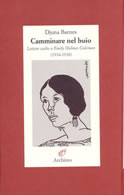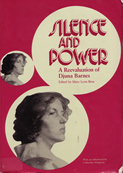BOOKS
 |
Camminare nel Buio (Black Walking: Selected Letters of Djuna Barnes to Emily Holmes Coleman , 1934-38) (Archinto, Milan, 2004; forthcoming in English)Djuna Barnes a Emily Coleman: una finestra sugli anni trenta, fra New York, Londra e Parigi; lettere da un rapporto spesso conflittuale fra due donne geniali e complesse, che si sono date reciproca licenza di scandagiliarsi nell’intimo. In totale liberta la Barnes parla degli ambienti che frequenta, di letteratura, di piccole cose quotidiane, di denaro, di rapporti con la famiglia e con amici comuni. E di complicati, impossibili amori, perche sia lei sia la Coleman sono per segreti motivi portate a coinvolgersi, entrambe intense e impetuose, con amanti tiepidi e riluttanti. Le lettere scelte coprono il periodo 1934-38, anni cruciali nei quali, mentre l’Europa veniva spinta (sull’orlo del cambiamento) l’autrice completa la sua opera piu famosa, Nightwood. Djuna Barnes, apprezzata da Eliot, Pound, Dylan Thomas, O’Neill, Montale e Joyce – al quale e per certi versi accostata – resta sorprendentemente, per il grande pubblico, (la piu famosa sconosciuta del secolo). |
| Djuna Barnes: Im Dunkeln gehn (Black Walking: Selected Letters of Djuna Barnes to Emily Holmes Coleman) (Klaus Wagenbach, Berlin, 2002) |
|
 |
Silence and Power: A Reevaluation of Djuna Barnes (London and Carbondale, Illinois: Southern Illinois University Press, 1991)” . . .the most important volume to date on Djuna Barnes . . .the collection has remarkable special features such as a section of personal reminiscences and clusters of brief quotations from previously unpublished letters and scattered memoirs. It includes abundant, well-selected photographs and prints of Barnes’s sketches and paintings, which clarify the essays; it also presents her troubled family history, which included her father’s bigamy and her probably rape and incest. . .”(Bonnie Kime Scott, Signs, Winter, 1993)”This most important volume to date on Barnes’s work is more than a collection of criticism, for it captures the eclectic character of the woman herself. . .there is no question that Barnes, to use the words of Broe, ‘destabilized the margins of establishment discourses and disciplines in modernist writing’. . .”(Noel Riley Fitch, Contemporary Literature XXXIII) “Now that cultural blinders have been lifted on childhood incest and trauma, we can read in Barnes’ writing the story of pain, protest and tragedy that was there before us all along. Barnes’s elaborate and densely allusive writing creates art as a form of defense against, or therapeutic transcendence of, a body and self defiled and betrayed by trusted more powerful others. To the credit of the editor, Mary Lynn Broe, and other contributors, many of the essays in Silence and Power underscore the tension between life and art by exploring Barnes’s charged representations of the sexualized and degraded body and the harrowing implications of family and relational politics” “Because of the essays this Afterword follows, we will be able to read Barnes, her pages and person, far more closely, explosively, and reliably than before. These essays, lightning bolts and laser beams of critical intelligence, will cauterize and change our perceptions of Barnes and cultural modernism. . .” (from Afterword, Catharine Stimpson) |
 |
Women’s Writing in Exile, co-edited with Angela Ingram (Chapel Hill: University of North Carolina Press, 1989) “Rooted in evocations of struggle, this work proposes ‘exile’ as a political reality and a political metaphor, ‘expatrations’ both inner and outer. A striking, salutary collection for feminist scholarship in its historical and cultural reconsideration of modernism.”(Rachel Blau DuPlessis, Temple University) “Critical readers of today’s feminist texts cannot afford to be exiled from Mary Lynn Broe and Angela Ingram’s provocative and challenging collection of essays. . . Broe continues to investigate the cultural rim in “My Art Belongs to Daddy,” an essay examining books with incest content as a major form of exile literature. In her opening collage of excerpts from Djuna Barnes, Emily Coleman, and Antonia White, Broe offers a “radical interruption of the sexual/textual order,”. . . ” (Mary Anne Scofield, Belles Lettres)
Contributors include Shari Benstock, Mary Lynn Broe, Susan Stanford Friedman, Susan Hardy Aiken, Judith Kegan Gardiner, Trudier Harris, Annette Kolodny, Sonia Saldivar-Hull, Celeste M. Schenck, Jane Marcus, Esther Fuchs, Angela Ingram, Louise Yelin, Sneja Gunew, and Gayatri Chakravorty Spivak. |
 |
Protean Poetic: The Poetry of Sylvia Plath (London and Columbia, MO: University of Missouri Press, 1980) Excerpts reprinted in Sylvia Plath: Modern Critical Views ed. Harold Bloom (New York and Philidephia: Chelsea House, 1989); and in anthology, Making Literature Matter, ed. Schilb and Clifford (New York; St.Martin’s/Bedford, 2006)
An abbreviated comment from the bookjacket of Mary Lynn Broe’s early study of Sylvia Plath: “Because she has been viewed primarily as a confessional poet, Sylvia Plath has been limited by a reputation based more on her life and death than on her work. Bibliographical problems as well as the public’s fascination with Plath’s personality have discouraged critical estimation of her poetry. This study of her poetic oeuvre – from early student poems to the posthumous volumes – attempts to demythologize Plath. Broe concentrates on a close and careful examination of the poet’s themes and techniques rather than dwelling on the lurid details of her life. She shows that Plath’s imaginative, emotional and dramatic range was wider, and her artistic control greater, than critics have generally recognized. She maintains that, even when her subject was urgently personal, Plath never lost control of her material. In the transitional poems in Crossing the Water, Plath mastered the conflicts between imagination and the reality that had shaped her work from the beginning, forging. . . a tonal authority that shaped her best-known late poems. . . this is the first extended critical evaluation that. . . avoids gossip and morbidity. . . It is a serious poetic reading of a serious poet with a finely controlled sense of humor.”
“. . .Broe carefully traces the growth of Plath’s poetic from the early poetry and prose to the posthumous works, examining as much of the canon as is now available. Broe shows how Plath’s increasing artistic control of her subject produces her ultimate poetic achievement: the mature treatment of dialectic; the ability to reinterpret history, myth, stereotype and received imagery. . .and the extraordinary range of emotion and response. The book is also significant as the first comprehensive study of voice and tone in Plath’s poetry” (Library Journal,Vol 106, #3; Feb 1, 1981)
” . . .Broe provides us with a good deal of valuable analysis of Plath’s rise from precocious undergraduate to renowned poet. . Broe emphasizes Plath’s ‘synthesizing spirit” (p.181), tracing her developmen from the fledgling poet held in “suspense/on the quiicksands of ambivalence”. . .to the more mature artist who learned to “employ its challenge to create one of the most innovative emotional ranges of any modern poet (p.180). . . Broe’s solidly documented and refreshingly sober analysis should bolster Plath’s reputatio as a major mid-century American poet. . .Broe’s exceptionally lucid style. . [achieves] an elegance too often absent in such specialized academic studies as this one.” (American Literature, Vol 53, No. 3, November, 1981)
“. . .Mary Lynn Broe wishes to demythologize Plath, to rescue her from those who see her as a confessional poet . . Broe shows us how, among other things, Plath turned to a cache of women’s myths to images of pregnancy, stillbirth, abortion, aging and wryly inverted them.”The sheep know where they are,” one poem begins. “The black slots of their pupils take me in./It is like being mailed into space . . .”They stand about in grandmotherly disguise / All wig curls and yellow teeth/ And hard, marbly baas.” Maturing, Plath identifies even less with sheep and more with the lioness. “Give me back my shape,” she cries out . . .Broe convincingly describes Plath’s maturation as a poet. . .precisely as scholarship should, this book renews one’s delight in its subject.” (from Joan Joffe Hall,”Laing and Plath: Dismissing One Poet, Demythologizing Another,” Feb 26, 1981) |
